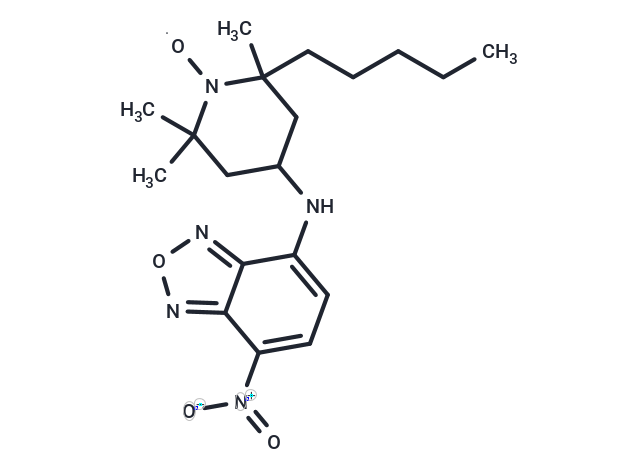Shopping Cart
Remove All Your shopping cart is currently empty
Your shopping cart is currently empty
NBD-Pen is a fluorescent probe that detects lipid free radicals in living cells.

| Pack Size | Price | USA Warehouse | Global Warehouse | Quantity |
|---|---|---|---|---|
| 1 mg | $118 | In Stock | In Stock | |
| 5 mg | $297 | In Stock | In Stock | |
| 10 mg | $446 | - | In Stock | |
| 25 mg | $893 | - | In Stock | |
| 50 mg | $1,330 | - | In Stock |
| Description | NBD-Pen is a fluorescent probe that detects lipid free radicals in living cells. |
| Cell Research | Instructions I. Reagent preparation 1. Solvent: NBD-Pen is usually provided in powder form and needs to be dissolved with an appropriate solvent (such as dimethyl sulfoxide (DMSO) or ethanol) before use. 2. Concentration: To prepare the working solution, the common concentration range is 10-50 µM. The specific concentration can be adjusted according to the experimental requirements. II. Operation steps 1. Cell treatment: 1) Cell culture: Plant the cells to be treated in a suitable culture medium, such as DMEM or RPMI-1640, and culture for 24 hours to adapt the cells. 2) NBD-Pen labeling: Add the dissolved NBD-Pen solution to the cell culture medium to ensure that its concentration is within the working range. Typically, cells are incubated at 37°C for 30 minutes to 1 hour to ensure that NBD-Pen is absorbed by the cells. 3) Washing: After incubation, gently wash the cells with PBS buffer or cell culture medium to remove the probe that has not entered the cells. 2. Fluorescence detection: 1) Fluorescence microscopy: When using a fluorescence microscope for detection, the excitation wavelength of NBD-Pen is about 460 nm and the emission wavelength is about 530 nm. The generation of lipid free radicals will lead to a strong enhancement of the fluorescence signal. 2) Flow cytometry: Flow cytometry can also be used to perform fluorescence detection on the treated cells to observe the changes in intracellular fluorescence. 3. Data analysis: 1) Fluorescence intensity: By analyzing the fluorescence intensity in the cells, the degree of generation of intracellular lipid free radicals can be evaluated. The higher the fluorescence intensity, the more significant the lipid peroxidation reaction. 2) Standard curve: In some quantitative experiments, the concentration of lipid free radicals can be further quantified by establishing a standard curve. Notes: 1. Solubility: NBD-Pen has good solubility, but it should be ensured that the solvent used does not have a negative impact on the activity of the cells. 2. Fluorescence bleaching: When performing fluorescence microscopy observation, long-term strong light exposure should be avoided to prevent bleaching of the probe fluorescence signal. 3. Experimental control: A blank group and a control group need to be set up in the experiment to ensure the accuracy of the experimental data. |
| Synonyms | NBDPen, NBD Pen |
| Molecular Weight | 390.46 |
| Formula | C19H28N5O4 |
| Cas No. | 1955505-54-0 |
| Smiles | CC(N([O])C(C)(CCCCC)C1)(C)CC1NC2=CC=C([N+]([O-])=O)C3=NON=C23 |
| Relative Density. | no data available |
| Storage | store at low temperature | Powder: -20°C for 3 years | In solvent: -80°C for 1 year | Shipping with blue ice/Shipping at ambient temperature. |
| Size | Quantity | Unit Price | Amount | Operation |
|---|

Copyright © 2015-2025 TargetMol Chemicals Inc. All Rights Reserved.